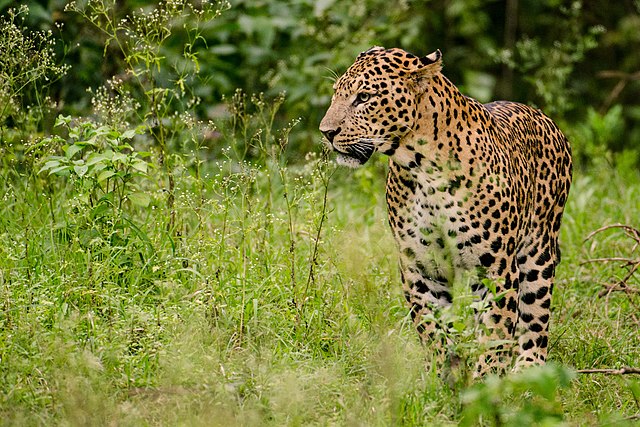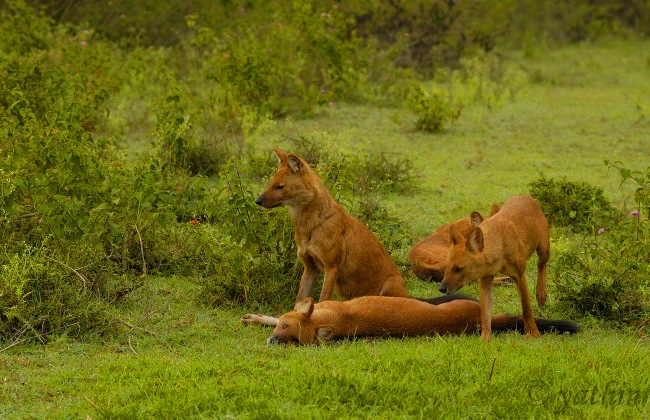Post by dinosauria101 on Apr 20, 2019 3:46:13 GMT 5
Indian Leopard - Panthera pardus fusca
The Indian leopard (Panthera pardus fusca) is a leopard subspecies widely distributed on the Indian subcontinent. The species Panthera pardus is listed as Vulnerable on the IUCN Red List because populations have declined following habitat loss and fragmentation, poaching for the illegal trade of skins and body parts, and persecution due to conflict situations. The Indian leopard is one of the big cats occurring on the Indian subcontinent, apart from the Asiatic lion, Bengal tiger, snow leopard and clouded leopard. Male Indian leopards grow to between 4 ft 2 in (127 cm) and 4 ft 8 in (142 cm) in body size with a 2 ft 6 in (76 cm) to 3 ft (91 cm) long tail and weigh between 110 and 170 lb (50 and 77 kg). Females are smaller, growing to between 3 ft 5 in (104 cm) and 3 ft 10 in (117 cm) in body size with a 2 ft 6 in (76 cm) to 2 ft 10.5 in (87.6 cm) long tail, and weigh between 64 and 75 lb (29 and 34 kg). Sexually dimorphic, males are larger and heavier than females. The leopard is a versatile, opportunistic hunter, and has a very broad diet. It is able to take large prey due to its massive skull and powerful jaw muscles. In Sariska Tiger Reserve, the dietary spectrum of the Indian leopard includes axis deer, sambar deer, nilgai, wild boar, common langur, Indian hare and peafowl. In Periyar Tiger Reserve, primates make up a large proportion of its diet.

Dhole (pack of 5) - Cuon alpinus
The dhole (Cuon alpinus) is a species of canid native to South and Southeast Asia. It is the only extant member of the genus Cuon, which differs from Canis by the reduced number of molars and greater number of teats. The dholes are classed as endangered by the IUCN, due to ongoing habitat loss, depletion of its prey base, competition from other predators, persecution and possibly diseases from domestic and feral dogs. The dhole is a highly social animal, living in large clans which occasionally split up into small packs to hunt. It primarily preys on medium-sized ungulates, which it hunts by tiring them out in long chases, and kills by disemboweling them. Unlike most social canids (but similar to African wild dogs), dholes let their pups eat first at a kill. Though fearful of humans, dhole packs are bold enough to attack large and dangerous animals such as wild boar, water buffalo, and even tigers. Prey animals in India include chital, sambar, muntjac, mouse deer, swamp deer, wild boar, gaur, water buffalo, banteng, cattle, nilgai, goats, Indian hares, Himalayan field rats and langurs. They are smaller than African wild dogs. Weight ranges from 10 to 25 kg (22 to 55 lb), with males averaging about 4.5 kg (9.9 lb) heavier. This dog is 88 to 113 cm (35 to 44 in) long from the snout to the base of the tail, with the tail averaging 45 cm (18 in) in length. Shoulder height is 42 to 55 cm (17 to 22 in).

Credit to Wikipedia
The Indian leopard (Panthera pardus fusca) is a leopard subspecies widely distributed on the Indian subcontinent. The species Panthera pardus is listed as Vulnerable on the IUCN Red List because populations have declined following habitat loss and fragmentation, poaching for the illegal trade of skins and body parts, and persecution due to conflict situations. The Indian leopard is one of the big cats occurring on the Indian subcontinent, apart from the Asiatic lion, Bengal tiger, snow leopard and clouded leopard. Male Indian leopards grow to between 4 ft 2 in (127 cm) and 4 ft 8 in (142 cm) in body size with a 2 ft 6 in (76 cm) to 3 ft (91 cm) long tail and weigh between 110 and 170 lb (50 and 77 kg). Females are smaller, growing to between 3 ft 5 in (104 cm) and 3 ft 10 in (117 cm) in body size with a 2 ft 6 in (76 cm) to 2 ft 10.5 in (87.6 cm) long tail, and weigh between 64 and 75 lb (29 and 34 kg). Sexually dimorphic, males are larger and heavier than females. The leopard is a versatile, opportunistic hunter, and has a very broad diet. It is able to take large prey due to its massive skull and powerful jaw muscles. In Sariska Tiger Reserve, the dietary spectrum of the Indian leopard includes axis deer, sambar deer, nilgai, wild boar, common langur, Indian hare and peafowl. In Periyar Tiger Reserve, primates make up a large proportion of its diet.

Dhole (pack of 5) - Cuon alpinus
The dhole (Cuon alpinus) is a species of canid native to South and Southeast Asia. It is the only extant member of the genus Cuon, which differs from Canis by the reduced number of molars and greater number of teats. The dholes are classed as endangered by the IUCN, due to ongoing habitat loss, depletion of its prey base, competition from other predators, persecution and possibly diseases from domestic and feral dogs. The dhole is a highly social animal, living in large clans which occasionally split up into small packs to hunt. It primarily preys on medium-sized ungulates, which it hunts by tiring them out in long chases, and kills by disemboweling them. Unlike most social canids (but similar to African wild dogs), dholes let their pups eat first at a kill. Though fearful of humans, dhole packs are bold enough to attack large and dangerous animals such as wild boar, water buffalo, and even tigers. Prey animals in India include chital, sambar, muntjac, mouse deer, swamp deer, wild boar, gaur, water buffalo, banteng, cattle, nilgai, goats, Indian hares, Himalayan field rats and langurs. They are smaller than African wild dogs. Weight ranges from 10 to 25 kg (22 to 55 lb), with males averaging about 4.5 kg (9.9 lb) heavier. This dog is 88 to 113 cm (35 to 44 in) long from the snout to the base of the tail, with the tail averaging 45 cm (18 in) in length. Shoulder height is 42 to 55 cm (17 to 22 in).

Credit to Wikipedia



